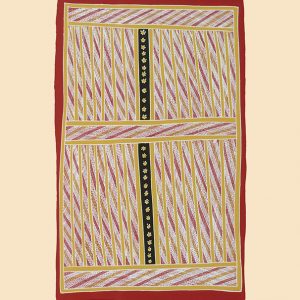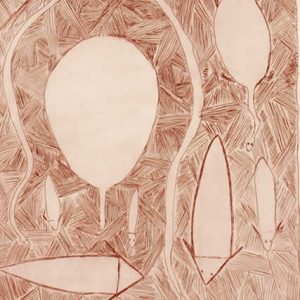Description
The Ganalbingu group and their related clans call the northwest wind that blows in from over the sea in the late afternoon during the dry season in northern Australia lunggurruma. This design is painted on the bodies of Ganalpingu and Djarrawitjibi men during ceremonies such as djapi ‘young man’s initiation’, murrakundja, a public diplomacy ceremony, and for various mortuary rituals. The triangular shapes refer to the clouds associated with lunggurruma, while the spots refer to the lightning and rain. The vertical lines in the print distinguish this version of the design as Djarrawitjibi. It is associated with Bulunbulun’s mother’s mother’s country, at a place called wark-murru or bolin-murru. The significance of lunnggurruma derives from its status as a symbolic emblem central to a number of aspects of Ganalpingu religious thought. One of these relates to the importance of the changes in the prevailing winds that mark the transitions of seasons throughout the seasonal cycles. For a hunter-gatherer people, food availability and movements around different parts of the country are closely tied with the changes in seasons, and people’s knowledge of their world involves an intimate understanding of the indicators of seasonal change. Seasonal change is what drives the continuation of life and the fertility of the natural world, and these are important themes in Aboriginal ceremony and visual art. The arrival of Lunggurruma is especially marked as it heralds the onset of the monsoonal rains after a long period of dry, hot weather. Lunggurruma is also central to the Ganalpingu’s public diplomacy ceremony called murrakundja. This ceremony celebrates the long association between people of their regional group with the Macassan trepand fishermen from Sulawesi. For several hundred years Macassan boats would arrive on the northwest monsoon winds, stay throughout the wet season and return to Sulawesi when the prevailing winds swung around to the southeast at the end of the rainy season. The murrakundja ceremony enacts a number of ritual themes associated with lunggurruma, including one stage of the ceremony when a dancer wearing the lunggurruma body design climbs a tree placed in the centre of the ceremonial ground. This tree is said to be a lunggurruma tree, and the dancer climbing it is like the wind that swept across, up and around the tree during its creation. Bulunbulun says that the four colours that comprise the lunggurruma design – galatjal ‘black’, gamanungku ‘white’, miku ‘red’ and butjalak ‘yellow’ – stand for the four Yirritja subsections: Bangardi, Bulany, Gojok and Ngarritj. Every Giritja person falls into one or other of these subsections.





